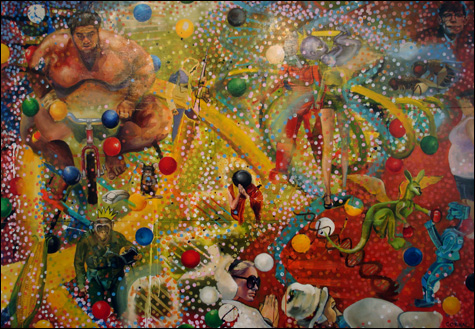
COSMIC CACOPHONY: “Gumball Genetics.” |
Biddeford artist Gil Corral seems to be one of those people whose curiosity and surreality often seem detached from everyday, practical matters, but who can at times distill that perspective to impossibly simple truth. His paintings, on display at Franklin Street Art Space, evince both a passion for armchair philosophy and a desire to use art as a means to plumb his subconscious. For the viewer, the body of work is off-putting at times but ultimately invaluable.
In “Gumball Genetics,” Corral depicts nothing short of a cataclysm of consciousness. Human remembrance is rendered as a collision of objecthood and our species’s strange tendency to symbolize. A gumball galaxy of pink, orange, and white polka-dots becomes a primordial sea from which explodes a big bang of images. A sumo wrestler rides a tricycle. A computer mouse rests next to its namesake from the animal kingdom. The Dalai Lama bows piously but his head is replaced with a jet black orb. Below him, a woman with a familiar air of celebrity repeats his gesture. Bees mate while Stephen Hawking presides over the entire scene. A common theme of DNA helixes weaving through the composition suggests the artist is attempting to depict a zero point of the Platonic and the scientific. Somewhere between our observational abilities and powers of imagination is a cosmic code from which we ourselves are written — our striving for a sense of progress and the material is seen in a new light.

If all this sounds like a bit much before your morning cup of coffee, that sense of unsettling chaos is reflected in the work. Corral forgoes a refined painterly approach in favor of excitable execution, resulting in an impressive conversation piece that otherwise could benefit from further development of form. Smaller pieces in the show follow suit. The horse on a yoga ball in “Charioteer” or the human-animal hybrids of “Sensitive” are alluring in concept but feel more like studies than works capable of projecting the undercurrents of consciousness and emotion with which Corral consumes himself.
That unease and underdevelopment disappears completely when Corral simplifies his content. In “Board,” the subject is reduced to pure sky and a lone bumblebee, resulting in the artist directing his intuitive sensitivity away from concerns of the mind and toward a physical approach to the materials of the piece itself. A blue sky is pushed almost entirely to white, the paint built up confidently with a palette knife. Subtle reds become minor epiphanies within a color-field that supports a bee rendered so softly and swaddled in resin to give the whole piece greater physical presence. Corral rips through the thick paint at the bottom of the canvas in two decisive strokes of the knife as though to make the air manifest and show us the underlying fabric of both the painting and the world it represents. The most successful work in the show, “Board,” is less about questions and process and instead elicits a Zen-like calm of “this IS.”
Corral’s success with simplification is not limited to peaceful interpretations. “Waiting” is an ominous work weighted down with murky browns. Starting with aging linoleum, the artist builds up the paint with an eye for its inherent disintegration. The material warps and cracks; old patterns poke through. Hints of blue and red with sweeping strokes of brown highlight the existing topography and transform the antique trash into a monolithic artifact. As you sit with the piece, a sense of presence overcomes you and then you notice an eye looking back at you. The image starts to become more clear and you’re struck with the ghostly visage of an elephant.
The power to transform what is already there, to charge the ordinary with emotion and attention is under the jurisdiction of shamans in most cultures. To say this comes naturally to Gil Corral is probably selling him short. While some painters focus on their craft in a purely technical direction, Corral’s transformative ability requires an equivalent discipline and practice. Corral’s scattered approach is a welcome counterpoint to the simple truths he can offer.
Ian Paige can be reached at ianpaige@gmail.com.